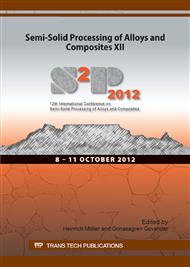p.347
p.353
p.359
p.365
p.373
p.379
p.386
p.392
p.398
New Developments with the SEED Technology
Abstract:
The SEED technology, a rheocasting process based on the slurry-on-demand approach, is an emerging technology that was developed in the mid-2000s. Many publications with regard to the process and to alloy development using this technology were made since, and several industrial units are operated worldwide. Moreover, the process is still actively developed and is fully supported by a team of scientists, engineers and technicians. With a global objective of addressing the user requirements and the industry needs, works were conducted toward optimization of the process and equipment. At first, the focus was on developing a simplified version of the SEED process to eliminate the so-called “drainage” phase while preserving the prime quality of the slurry produced. Improvement of some system components and integration of new features were also targeted to secure the overall equipment efficiency (OEE) and increase the process reliability. This work, backed with the optimization of process parameters and comprehensive techniques adapted for semi solid casting, led to the consolidation and even improvement of the properties of the parts produced for the common foundry alloys 356/357 and 319. Furthermore, the non-drained SEED version was applied to the validation of the process capabilities for uncommon cast alloys with works on 6061 wrought alloy, Duralcan metal matrix composite, and others. The results confirmed that the SEED process can efficiently be used in non-drained mode and achieve the same quality of slurry as the drained version originally developed. It is now proven in the industrial scale and actually integrated in the updated industrial equipment. Moreover, the capabilities of the process for special alloys and applications are still the subject of active development works.
Info:
Periodical:
Pages:
373-378
Citation:
Online since:
October 2012
Authors:
Keywords:
Price:
Сopyright:
© 2013 Trans Tech Publications Ltd. All Rights Reserved
Share:
Citation:


